Farmer Asphyxiated Due to Lack of Oxygen After Entering an Oxygen Limiting Silo 3 Days After Filling
Investigation: # 02MI143
SUMMARY
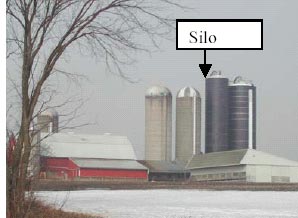 |
| Photo 1 – Silo on farm |
On October 8, 2002, a 46-year old male dairy farmer entered a 90-foot tall oxygen-limiting silo to adjust some lines for the air bladder system. Three days earlier, he had filled the silo (Photo 1) with high-moisture shelled corn. Upon filling, he climbed to the top of the silo and discovered that corn covered the lines. He waited for three days to allow the corn to settle before attempting to retrieve the lines. He and a coworker climbed the fixed ladder to the top of the silo and opened the hatch. The victim hung a rope with knots to climb down into the silo, approximately 8-10 feet. The victim entered the silo; the coworker remained outside of the silo. No odor was present upon opening the silo hatch. “Silo gas” may not exhibit any detectable odor. The blower was not running. The victim entered the silo and cried out for help. The coworker reached for the victim’s wrist but could not pull him out. The coworker called the victim’s wife for help. The wife sent another family member to assist and also called for emergency assistance. The coworker and family member remained outside of the silo waiting for emergency assistance. Emergency assistance arrived and extricated the victim from the silo. He was pronounced dead at the scene.
RECOMMENDATIONS
- Prior to entry into a silo, set up and run the blower to force air into the silo for at least 30 minutes to minimize the possibility of the air space above the silage to contain a hazardous atmosphere. Employees must follow the confined space entry procedures as required under MIOSHA Part 90, Confined Space Entry rules.
- Prior to entry into the silo, test the air for lack of oxygen to support life and/or oxides of nitrogen or elevated carbon dioxide
- The blower should be left running while inside the silo.
- Identify all confined spaces on the farm (such as silos, manure pits, grain bins, tanks, etc.) and develop a confined space entry program, that complies with the MIOSHA Part 90, Confined Space Entry, to minimize exposure to the hazards involved when entering the confined space.
- Equipment owners should ensure that relevant manuals, such as an owner’s and/or operator’s manual are available to make sure safe work practices and appropriate service/maintenance schedules are developed and implemented.
Additionally, MIFACE recommends that fire departments and other emergency responders who conduct rescue/body-retrieval operations become familiar with confined spaces in agricultural settings and have appropriate respiratory protection devices that allow safe entry without jeopardizing the safety of the rescuers.
INTRODUCTION
On Tuesday, October 8, 2002, a 46-year old dairy farmer was asphyxiated due to a lack of oxygen to support life after entering a 90-foot tall oxygen-limiting silo. On October 9, 2002, MIFACE investigators were informed by a local reporter that the individual died the previous day. Working with the local agricultural extension office, a visit to the family farm was scheduled on March 17, 2003. The victim’s wife and the coworker present at the time of the incident talked with the MIFACE researchers. The police report, death certificate, and an operator’s manual for the silo were obtained as part of the investigation.
The family dairy farm had approximately 300 head of dairy cows and grew their own corn. The farm owned approximately 600 acres and rented approximately 400 acres. The victim was the owner of the dairy farm, farmed full-time, and was very methodical in approaching all of the farm tasks. Four family members also worked part time on the farm. The victim provided on-the-job safety training to his family members. He did not have a voluntary written farm safety program. He did not have an operator’s manual for the silo.
INVESTIGATION
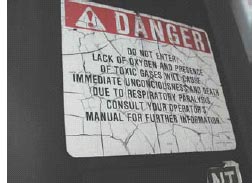 |
| Photo 2 – Silo confined space warning sign |
There are three general types of silos – horizontal (subdivided into trench, bunker or stack), conventional upright or vertical top unloading silo (with or without a roof) and oxygen-limiting. The silo involved in this incident was a Harvestore oxygen-limiting silo, 20 feet in diameter and 90 feet tall. The silo is made of bolted panels of glass-fused to steel. The steel sheets are fastened together using steel bolts and sealants. The construction of the sealed silo limits the amount of air that comes into contact with the silage. To minimize the amount of air mixing with the fermentation gases, the silo has a pressure relief valve that will release pressurized air from inside the silo if the pressure exceeds the capacity of the breather bags. The breather bags are designed to reduce the amount of air that comes in contact with the fermentation gases and stored feed; the inward and outward air movement occurs within the breather bags instead of within the structure of the silo. A blower places the stored material into the silo from a top door; the unloader is located beneath the corn. The warning label for the silo was present and readable (Photo 2), although not located near the bottom of the ladder (Photo 3). The MIFACE investigators did not climb to the top of the silo to see if the warning signs were present at the silo entry points.
Three days prior to entry, the victim and friend/coworker were filling the silo with high-moisture shelled corn. They filled the oxygen-limiting silo to the top, so the corn reached the bottom of the air bladders. Upon completion of filling the silo on Saturday afternoon, October 5, they climbed the ladder to the top of the silo to gather the ropes for the air bladders. Upon opening the hatch, they discovered that the ropes for the air bladders were under the shelled corn and could not be retrieved.
The victim decided to allow the corn to settle a while, so they waited until Saturday night to try to gather the ropes. The ropes were still under the grain so they could not raise the air bags. At this time, the victim shut the silo hatch on Saturday night.
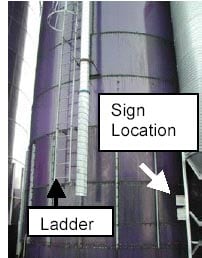 |
| Photo 3 – Location of confined space warning sign |
His usual work procedure would be to let the corn settle overnight then would fill the rest of the silo the following day. He had a different work procedure for this silo fill. He had been feeding the dairy cattle from this silo since Saturday. He checked the level of the corn in the silo on Monday night. There was no coning in the center of the feed and no further settling had occurred, indicating an apparent bridging of the shelled corn.
The coworker who worked with the victim on Saturday was with him again on Tuesday morning. They climbed up the ladder of the silo and opened the roof side hatch. The opening was approximately 18 inches in diameter. According to the coworker, the tractor was hooked up to the blower but the blower was not running at the time of entry. The friend could not smell anything “funny” when the silo hatch was opened and the victim entered.
A knotted rope was placed into the silo and the victim entered the silo to try to remove the ropes submerged in the corn for raising the breather bags inside the silo to allow the silo to be topped off with two or three more truckloads of corn. The corn was down 8-10 feet inside the silo. The victim entered the silo and was just below the hatch level when he called out to his friend that he couldn’t breathe. The friend grabbed his wrist and attempted to pull him from the silo, but could not. The victim passed out and fell to the corn below. The friend used his cell phone and called the victim’s wife for help. The wife sent her son to the top of the silo to assist. Emergency response was called, and, after the victim was recovered from the silo, the victim was declared dead at the scene. The victim died of asphyxiation when he was overcome by lack of oxygen caused by carbon dioxide inside the silo as determined by the medical examiner.
CAUSE OF DEATH
The cause of death as stated on the death certificate was acute asphyxia due to a farm accident. An autopsy and toxicology tests were not performed.
RECOMMENDATIONS/DISCUSSION
• Prior to entry into a silo, set up and run the blower to force air into the silo for at least 30 minutes to minimize the possibility of the air space above the silage to contain a hazardous atmosphere. Employees must follow confined space entry procedures as required under MIOSHA Part 90, Confined Space Entry rules.
A hazardous atmosphere is an atmosphere that may expose an individual to the risk of death, incapacitation, impairment of ability to self-rescue, injury, or acute illness. An oxygen deficient (asphyxiating) atmosphere and/or atmospheres containing toxic contaminants are common hazardous atmospheres found within a silo. An additional hazard, although not commonly found on family farms, is the development of an explosive atmosphere within the silo due to combustible dusts generated during loading or other activities. On a more chronic basis, there is the potential of an allergic reaction to the silage or microbiological contaminants.
A hazardous atmosphere containing an asphyxiating or toxic contaminant is due to the formation of silo gas during the ensiling process within the silo. During ensiling, carbon dioxide (CO2) is always produced; in oxygen limiting silos, CO2 in the atmosphere poses the greatest atmospheric hazard. Asphyxiation can occur when the oxygen content of the air inside a bin becomes too low to support life. In horizontal and conventional upright silos, oxides of nitrogen (NOx) may also be produced in considerable quantities in the first 48 hours and up to two weeks after initial filling of the silo. Appendix A contains information about oxygen deficient and toxic atmospheres.
To minimize the possibility of the area above the silage to contain a hazardous atmosphere, Agriculture Canada recommends that the forage blower should run for at least 30 minutes for silos up to 55-foot diameter. Larger structures and large area volume above the silage may require more ventilation time for safe entry. The blower should always be kept running while anyone is in the silo.
An Agriculture Canada study found that that forage blowers do an effective job of ventilating a silo headspace provided that silage was no more than 16 feet below the distributor hood. If the depth of settled silage is more than 16 feet from the top of the silo, attach a tube adaptor to the blower pipe. To better direct the air-blast downward and prevent interference by the silage distributor, securely tie in place a length of 8 inch wire-wound flexible exhaust ducting to the blower pipe. See Figures 1 and 2 in Appendix B illustrations depicting the exhaust ducting.
• Prior to entry into the silo, test the air for lack of oxygen to support life and/or oxides of nitrogen or elevated carbon dioxide.
After running the blower and before entering the silo, the air inside the silo should be tested to gather information about the atmospheric conditions. The oxygen level of the atmosphere should always be tested first. Next test for other air contaminants, like silo gas (carbon dioxide and nitrogen dioxide).
To measure the concentration of oxygen or other air contaminants, an electronic direct-reading instrument or a colorimetric detector tube can be used. Electronic devices display a digital readout and are the most accurate. They are also very expensive, difficult to maintain, require frequent calibration, and may not hold up well in agricultural operations.
A less expensive method to test the air is to use colorimetric detector tubes for carbon dioxide and nitrogen dioxide. Due to potential inaccuracy for oxygen reading, it may not be practical to use a colorimetric tube for oxygen measurement. Colorimetric detector tubes are glass vials filled with a chemical reagent that reacts to a specific chemical or family of chemicals. A sample of air is drawn through the tube with a bellows pump that can be hand operated or electric. If the targeted chemical(s) is present in the air being sampled, the reagent in the tube changes color and the length of the color change indicates the measured concentration of the material in the air (± 25%). The detector tubes have a shelf life of approximately a year, and, if using a hand pump, it should be leak-tested prior to each use. To find an Internet source for colorimetric detector tubes, use the key words “colorimetric detector tubes”.
Air samples should be taken just above the lowest point of the silage surface. An extension tube up to 18 feet long that is provided by the manufacturer can be attached to the pump to reach down into the silo. The air test should be conducted outside of the silo; at no time should the individual conducting the testing enter the silo without adequate air-supplied respiratory protection to take a sample of the air. The test should be repeated two times to check repeatability accuracy of results.
• The blower should be left running while inside the silo.
A continuous fresh air supply is critical in maintaining an atmosphere that is non-hazardous while inside the silo. This can be accomplished by running the blower continuously while inside the silo. Ensure that the blower effectively ventilates all dead air spaces within the silo.
• Identify all confined spaces on the farm (such as silos, manure pits, grain bins, tanks, etc.) and develop a confined space entry program, that complies with the MIOSHA Part 90, Confined Space Entry, to minimize exposure to the hazards involved when entering the confined space.
The Michigan Occupational Safety and Health Act (MIOSHA) General Industry Safety Standards Part 90 defines a confined space as a space that: (a) is large enough and so configured that an employee can bodily enter and perform assigned work; and (b) has limited or restricted means for entry or exit (for example, tanks, vessels, silos, storage bins, hoppers, vaults and pits are spaces that may have limited means of entry); and (c) is not designed for continuous employee occupancy.
If the confined space has one or more of the following characteristics, the confined space would be considered a permit-required confined space. The characteristics of a permit-required confined space are: (a) contains or has the potential to contain a hazardous atmosphere, (b) contains a material that has the potential for engulfing an entrant; (c) has an internal configuration such that an entrant could be trapped or asphyxiated by inwardly converging walls or by a floor which slopes downward and tapers to a smaller cross-section or (d) contains any other recognized serious safety or health hazard.
A silo meets many of the criteria for a confined space and can be considered a permit required confined space. All farm owners should develop a confined space entry program to minimize exposure to the hazards involved when entering a confined space. At a minimum, the confined space entry should include:
- An evaluation to determine whether entry is necessary
- Correct use of safeguards
- Testing and monitoring of air quality
- The concentration of oxygen in the air should not be lower than 19.5%
- The concentration of carbon dioxide in the air should be less than 10,000 parts per million (ppm) or 1.0%
- The concentration of nitrogen dioxide in the air should be less than 1.0 ppm.
- Use of proper ventilation equipment and procedures
- Use of safety harness and lifelines
- Stationing, at a minimum, 2 standby attendants outside the space for communication and visual monitoring
- Instruction of farm workers and family members in safe confined space rescue procedures.
NIOSH publication 87-113 “A Guide to Safety in Confined Spaces” may be used as an additional resource guide for entering a confined space. Although not all of the items are applicable to agricultural situations, some general concepts that are applicable are as follows:
- Is entry necessary? Can the assigned task be completed from the outside?
- Are confined spaces posted with warning signs and are confined space procedures posted where they will be noticed by all who are to work in and around the confined space?
- Are confined spaces tested before entry and continuously monitored while work is being performed?
- Is ventilation equipment available and adequate for the work to be performed?
- Do persons entering the confined space know how and when to use protective clothing (including gloves, safety glasses, etc), respiratory protection, safety harness and lifelines and emergency rescue equipment?
- Are confined space safe work practices discussed before entering the space?
- Is there a confined space rescue plan developed and do others know how to safely respond in an emergency?
The federal Occupational Safety and Health Administration (OSHA) offers assistance on the Internet to assist agricultural operations identify confined spaces and deal with permit-required confined spaces. The OSHA Confined Spaces Advisor 1.1. provides expert help for the Permit-Required Confined Spaces Standard (29 CFR 1910.146). The program is available in both online and downloadable versions. The OSHA Confined Space Web site is located at https://www.osha.gov/SLTC/confinedspaces/index.htmlexternal icon. (Link updated 11/13/2006)
• Equipment owners should ensure that relevant manuals, such as an owner’s and/or operator’s manual are available to make sure safe work practices and appropriate service/maintenance schedules are developed and implemented.
The victim did not have an operator’s manual for the silo; this manual contains useful safety, operating, servicing and maintenance information. The silo operator’s manual contained general information about the silo and breather bag system, preventive maintenance guides, silo filling procedures, and safety guidelines for the silo.
The silo filling procedures included running the blower to help to deflate the bags prior to filling so they could be raised more easily. To minimize the possibility of damage to the breather bags and the breather bag cords being covered by grain, the manual recommended that the cords to raise the breather bags be pulled and tied to either the cam lock handle on the filler door ring (structures with center fill pipe) or to the rope cleats (structures equipped with ground control system – closed fill) prior to filling. After each day’s filling, the cords would be released and the bags lowered. A copy of the Harvestore Structure Operator’s Manual is included in this report. A copy of the manual may be downloaded from the MSU Occupational and Environmental Medicine Web site, Internet address: http://www.oem.msu.edu/Default.aspxexternal icon.(Link updated 8/5/2009) Select the MIFACE link; the Harvestore manual can be found on the MIFACE web site.
Additionally, MIFACE recommends that fire departments and other emergency responders who conduct rescue/body-retrieval operations become familiar with confined spaces in agricultural settings and have appropriate respiratory protection devices that allow safe entry without jeopardizing the safety of the rescuers.
Fire departments and other emergency responders should be trained to recognize potential confined spaces on farms, understand the hazards associated with confined spaces on farms, how to test the air quality in a confined space, and have a pressure-demand supplied air respirator with a long air hose as part of their emergency equipment to conduct a silo rescue. For Immediately Dangerous to Life and Health (IDLH) atmospheres, this type of respirator must be equipped with a small cylinder of escape air.
Self-contained breathing apparatus (SCUBA) equipment is not suitable because the air tank is too big for climbing the silo chute or the outside ladder as well as for entering the inside of the silo while wearing the SCUBA. The fire departments and other emergency responders should develop and implement a written respiratory protection program that complies with the requirements of MIOSHA Occupational Health Standard, Respiratory Protection, Part 451 and General Industry Safety Standard, Part 74, Fire Fighting.
REFERENCES
MIOSHA Standards cited in this report can be found at the Consumer and Industry Services, Bureau of Safety and Regulation Standards Division web site at http://www.michigan.gov/lara/0,4601,7-154-61256_11407_15368—,00.htmlexternal icon. (Link Updated 3/27/2013) Follow the links Workplace Safety & Health then Standards & Legislation to locate and download MIOSHA Standards.
The Standards can also be obtained for a fee by writing to the following address: Department of Consumer and Industry Services, MIOSHA Standards Division, P.O. Box 30643, Lansing, MI 48909-8143. MIOSHA phone number is (517) 322-1845.
- MDCIS Director’s Office, General Industry Safety Standards, Part 90, Confined Space Entry
- MDCIS Director’s Office, Occupational Health Standards, Part 451, Respiratory Protection.
- MDCIS, Director’s Office, Occupational Health Standards, Part 301, Air Contaminants.
- MDCIS Director’s Office, General Industry Safety Standards, Part 74, Fire Fighting
- Carbon Dioxide, Caves and You, Garry K Smith, 1997. Internet resource: http://nhvss.org.au/wp-content/publications/CO2.htmexternal icon (Link Updated 4/9/2015)
- Farm Safety Association Fact Sheet NO. F-010, September 1985. Silo Gas — a Swift and Silent Killer. Internet Address: http://www.fsai.on.ca/factsheets/SILOGA~1.PDF (Link no longer valid)
- Sabouring, H.M., W.S. Reid, J.E. Turnbull and M.Ihnat. 1982. Silo Gas Production, detection, ventilation and related safety procedures. Can. Soc. Of Agric. Eng. Paper no 82.207, presented at Ann. Conf. Vancouver, B.C. Contribution no I-421 from Eng. and Stat. Res. Center, Research Br., Agriculture Canada, Ottawa K1A OC6.
- Turnbull, J.E. 1984. Silo gas – What can be done? Proc., Int. Silo Safety Conf., Kitchener, Ont. Nov 28. Contribution no I-660, from Eng. and Stat. Res. Center, Research Br., Agriculture Canada, Ottawa K1A OC6.
- Silo Gas – Plan N-7410, Revised 88:06. Canada Plan Service. Internet Resource: http://www.cps.gov.on.ca/english/plans/E7000/7410/M-7410L.pdfpdf iconexternal icon
- NIOSH publication 87-113 “A Guide to Safety in Confined Spaces”. Internet resource: https://www.cdc.gov/niosh/docs/87-113/pdfs/87-113.pdfpdf icon
- Harvestore Structure Operator’s Manual, AO Smith, 550 W. Algonquin Road, Arlington Heights, Illinois 60005, Part #19871-74, dated 1/31/82.
- Silo Safety Project, August 2000-January 2001. Workplace Health and Safety Standards Applying to Silos, Queensland Government, AU. Internet Address: http://www.whs.qld.gov.au/research/industry/report09.pdf (Link no longer valid)
- National Ag Safety Database (NASD). http://www.nasdonline.org/index.htmlexternal icon Topic Areas: Grain Handling/Harvesting/Storage (Link updated 8/5/2009)
MIFACE (Michigan Fatality and Control Evaluation), Michigan State University (MSU) Occupational & Environmental Medicine, 117 West Fee Hall, East Lansing, Michigan 48824-1315. This information is for educational purposes only. This MIFACE report becomes public property upon publication and may be printed verbatim with credit to MSU. Reprinting cannot be used to endorse or advertise a commercial product or company. All rights reserved. MSU is an affirmative-action, equal opportunity employer. 6/12/03
To contact Michigan State FACE program personnel regarding State-based FACE reports, please use information listed on the Contact Sheet on the NIOSH FACE web site Please contact In-house FACE program personnel regarding In-house FACE reports and to gain assistance when State-FACE program personnel cannot be reached.
Appendix A
Hazardous Atmospheres
Effects of Lack of Oxygen
Normal air is about 21% oxygen, 79% nitrogen and 0.03% carbon dioxide. The human body can sustain life at oxygen levels below 21%. Table 1 describes the human response to differing levels of oxygen in the atmosphere.
| Oxygen Level (%) | Symptoms |
| 12-16 | Breathing and pulse rate increased, muscular coordination slightly disturbed |
| 10-14 | Consciousness continues, emotional upsets, abnormal fatigue upon exertion, disturbed respiration |
| 6-10 | Nausea and vomiting, inability to move freely, loss of consciousness may occur, may collapse and although aware of circumstances be unable to move or cry out |
| Below 6 | Convulsive movements, gasping respiration, respiration stops and a few minutes later heart action ceases |
| (source: Patty’s Industrial Hygiene and Toxicology, Vol. 2C, 3rd edition) | |
Oxides of Nitrogen (NOx)
In horizontal and conventional silos, oxides of nitrogen (NOx) are produced as a result of the nitrate (NO3) content of the plant material. During the fermentation process, the plant nitrogen is released as nitric oxide (NO). Nitric oxide mixes with the oxygen in the silo forming nitrogen dioxide (NO2). When NO2 is inhaled, it dissolves with the moisture in your lungs and forms nitric acid, which “burns” your lungs. NO2 gas is reddish to yellowish brown and can have a bleach-like odor, however, visual and/or odor cues may not present themselves inside upright silos.
CO2 production
During the ensiling process, the living plant material quickly uses up the limited supply of atmospheric oxygen contained within the silage (respiration). During respiration, the oxygen is converted into some water and CO2. At the same time, bacteria multiply rapidly in the silage and produce more CO2. The period of most rapid gas production is during the first 6-7 days after filling. The CO2 displaces the oxygen. This process occurs in an oxygen-limiting silo as well as in a conventional silo in a grain indentation.
In an oxygen-limiting silo, most if not all oxygen is absorbed by grains during respiration and is replaced by CO2. Carbon dioxide is not itself damaging to health. But in silos and similar tight spaces carbon dioxide can replace the oxygen in the air. In oxygen-limiting silos, the contained atmosphere will be almost entirely CO2 and nitrogen. Carbon dioxide poses an especially dangerous situation because an individual cannot see or smell anything that would indicate the oxygen content is too low or the carbon dioxide level was too high.
Effects of High Levels of CO2
CO2 is an odorless, tasteless, colorless gas that is 53% heavier than air. It will not rise, but sink to the lowest level. Therefore, carbon dioxide will be found in greater concentrations right above the grain surface. Symptoms of carbon dioxide inhalation at various air concentrations are described in Table 2.
| CO2 Concentration |
Symptoms |
| 0.03% | Nothing happens – this is normal. |
| 0.5% | Lung ventilation increases by 5 percent. |
| 1.0% | Symptoms may begin to occur, such as feeling hot and clammy, lack of attention to details, fatigue, anxiety, clumsiness and loss of energy, which is commonly first noticed as a weakness in the knees (jelly legs). Exposure permitted by Michigan Standards for an 8-hour day. |
| 2.0% | Lung ventilation increases by 50 percent, headache after several hours exposure. Accumulation of carbon dioxide in the body after prolonged breathing of air containing around 2% or greater will disturb body function by causing the tissue fluids to become too acidic. This will result in loss of energy and feeling run-down. It may take the person up to several days in a good environment for the body metabolism to return to normal. |
| 3.0% | Lung ventilation increased by 100 percent, panting after exertion. Symptoms may include: headaches, dizziness and possible vision disturbance such as speckled stars. Exposure permitted by Michigan Standards for a 15-minute period. |
| 4.0% | Exposure level considered Immediately Dangerous to Life or Health (IDLH) by NIOSH. |
| 5-10% | Violent panting and fatigue to the point of exhaustion merely from respiration & severe headache. Prolonged exposure at 5% could result in irreversible effects to health. Prolonged exposure at >6% could result in unconsciousness and death. |
| 10-15% | Intolerable panting, severe headaches and rapid exhaustion. Exposure for a few minutes will result in unconsciousness and suffocation without warning. |
| 25-30% | Extremely high concentrations will cause coma and convulsions within one minute of exposure. Certain Death. |
| Table 2 References: MIOSHA Standards Silo Gas, Plan N-7410, Canada Plan Service, Carbon Dioxide, Caves and You, Garry K. Smith, Silo Safety Project, Queensland Government, NASD | |
Appendix B
Figure 1
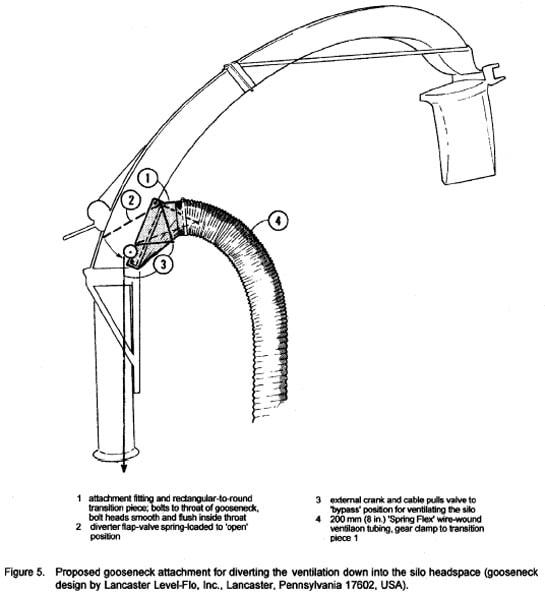
Reference: Silo Gas, Plan N-7410
Figure 2
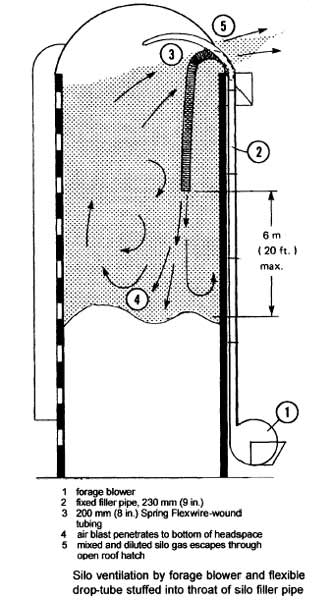
Reference: Silo Gas, Plan N-7410
Back to NIOSH FACE Web
